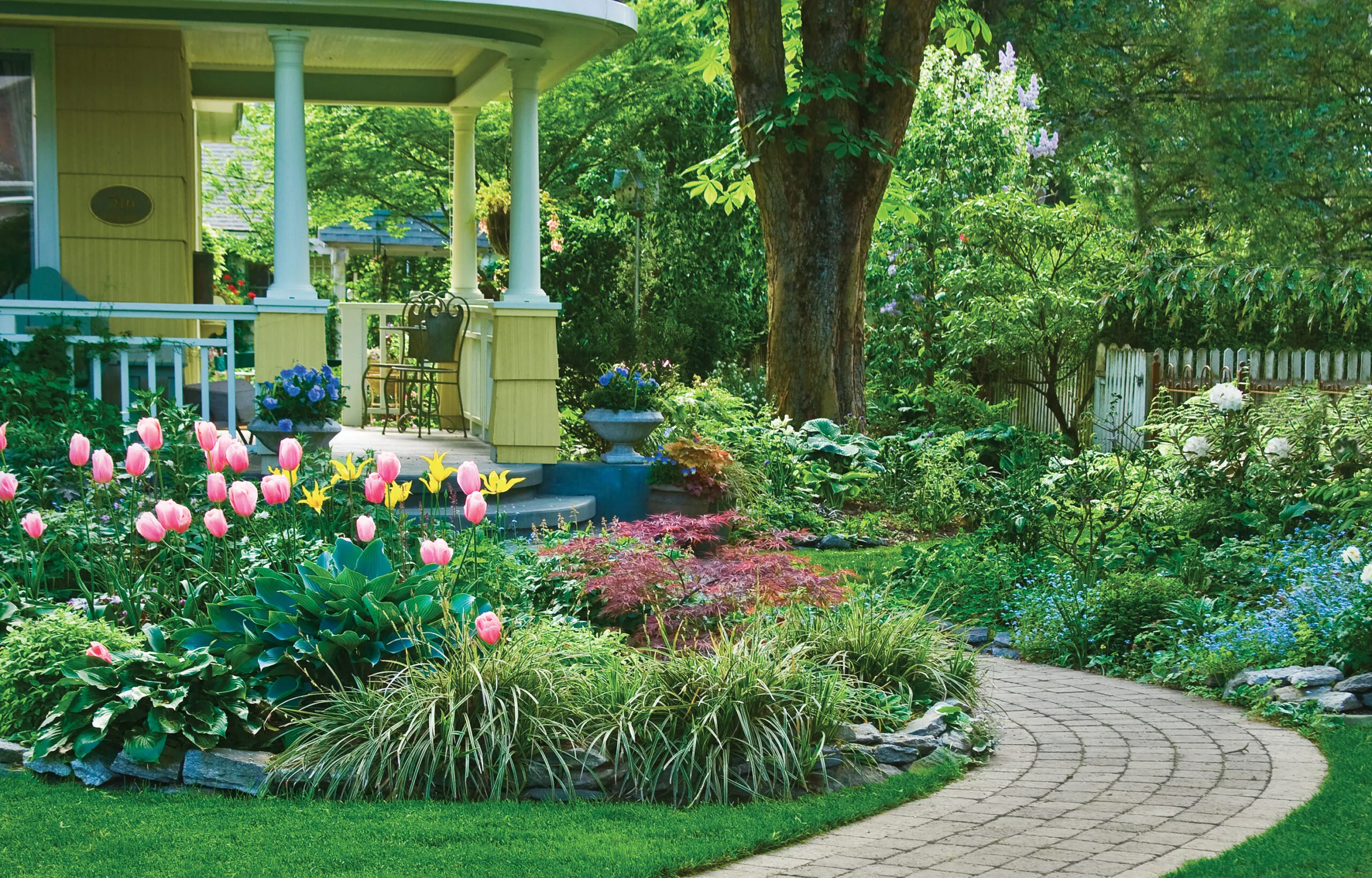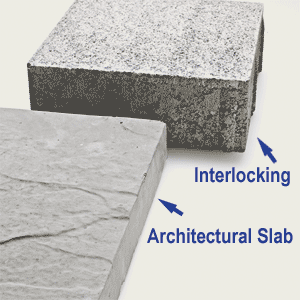
Concrete pavers are durable, stylish, and affordable for various hardscaping projects. They can transform your landscape, driveway, walkways, patio, or pool deck while offering practical benefits. In this guide, we explore concrete pavers, their types, advantages, installation process, and more to help you make an informed decision.
What Are Concrete Pavers?
Concrete pavers are pre-cast blocks that come in various shapes, colors, and sizes, offering you a wide range of design options for your outdoor spaces.
Manufacturers create concrete pavers by pouring a mixture of cement, sand, gravel, and water into molds. They then compress this mixture and cure it to build strong, uniform blocks. The composition can be adjusted to achieve different textures, colors, and strengths, such as faux stone or brick.
Types of Concrete Pavers
There are two main categories of concrete pavers: interlocking and architectural slab. Each type has unique characteristics and applications.
Interlocking Pavers
Interlocking pavers are the workhorses of the concrete paver family. These chunky blocks feature edge spacers that create uniform joints when installed. They’re made with a stiff, very strong concrete mix, resulting in a thick paver suitable for all uses, including driveways. Interlocking pavers often come with lifetime warranties for structural integrity, making them an excellent choice for high-traffic areas.
Architectural Slab Pavers
Architectural slab pavers are a nicer-looking alternative to their interlocking counterparts. These thinner blocks come from a wetter concrete mix to resemble natural stone or brick. While they lack edge spacers and aren’t suitable for driveways, architectural slab pavers provide a refined look for patios, walkways, and other areas with foot traffic only. They’re a cheaper way to achieve the appearance of more expensive materials such as natural stone.

Advantages of Using Concrete Pavers
Concrete pavers offer numerous benefits, which we’ll detail below.
Durability and Longevity
Concrete pavers are incredibly durable. When properly installed and maintained, they last for decades, even in harsh climates. They’re resistant to cracking, splitting, and other forms of damage that are common with poured concrete and asphalt surfaces, making them a cost-effective choice in the long run.
Aesthetic Versatility
Concrete pavers come in an extensive range of colors, shapes, and textures. Whether you’re aiming for a rustic, natural look or a modern, sleek appearance, there’s a concrete paver option to suit your style. You can also create patterns and borders with concrete pavers, adding visual interest to your outdoor spaces.
Easy Installation and Repair
Unlike poured concrete, which requires specialized equipment and expertise to install, concrete pavers are relatively easy to work with. Their modular nature allows for straightforward installation, often making them a viable DIY project for small areas. Additionally, it’s easy and affordable to repair concrete pavers. If a paver becomes damaged or stained, you can replace it without disturbing the entire surface.
Runoff Reduction
The joints between pavers allow for some water infiltration, reducing overall runoff. When combined with proper base preparation, paver systems can significantly improve site drainage and reduce the strain on municipal stormwater systems. You can also opt for permeable interlocking pavers, which have wider joints or special drainage channels that allow water to percolate through the paving system.
Potential Drawbacks of Concrete Pavers
While concrete pavers offer several advantages, you should also consider potential drawbacks before choosing them for your outdoor space.
Color Changes Over Time
One common concern with concrete pavers is the potential for color changes over time. Surface wear can reveal the underlying aggregate, altering the overall appearance of the pavers. This effect is more noticeable with solid-colored pavers and less so with variegated or tumbled pavers that already have a worn look. Some manufacturers offer faced pavers with an added wear layer to mitigate this issue, though these typically come at a higher cost.
Staining Issues
Concrete pavers are susceptible to staining, particularly from oil and other substances. While regular cleaning and maintenance help prevent stains, some may be difficult to remove completely. Applying a sealer can provide some protection against staining, but it requires reapplication every couple of years to maintain effectiveness.
Weed Growth in Joints
Weeds can grow in the joints between concrete pavers, especially if not properly maintained. Regular sweeping and occasional use of weed preventatives help keep this issue under control. Some homeowners opt for polymeric sand in the joints, which hardens and helps prevent weed growth while still allowing for some flexibility.
Comparing Concrete Pavers to Other Materials
Contrasting concrete pavers with other popular hardscaping materials will help you decide which is best for your needs.
Concrete Pavers vs. Poured Concrete
Concrete pavers are more flexible and less prone to cracking than poured concrete due to ground movement or freeze-thaw cycles. Pavers also provide better traction, especially on sloped surfaces. While poured concrete may be less expensive initially, pavers can last longer and are easier to repair, making them more cost-effective over time.
Concrete Pavers vs. Brick
Brick and concrete pavers look similar, but concrete pavers offer more color and shape options. Concrete pavers are typically less expensive than brick and offer greater strength and durability. However, brick maintains its color better over time and matches certain architectural styles better, such as Dutch Colonial.
Concrete Pavers vs. Natural Stone
Natural stone offers unparalleled beauty and uniqueness, but it comes at a higher cost than concrete pavers. Concrete pavers mimic the look of natural stone at a fraction of the price. They’re also more uniform in size and thickness, making installation easier. However, natural stone generally maintains its appearance better over time and may work better for high-end projects or historic properties.
Installation Process for Concrete Pavers
Installing concrete pavers requires careful planning and execution. While experienced DIYers can tackle small projects, larger installations are better left to the professionals.
Site Preparation
Site preparation involves excavating the area to the proper depth, accounting for the thickness of the pavers and base material. The site is also graded to check for proper drainage away from buildings and to prevent pooling water.
Laying the Base
A stable base is required for long-lasting paver installation. This typically involves laying compacted gravel followed by a layer of sand. The base must be level and properly compacted to prevent the pavers from settling and shifting over time. You may need a thicker base for areas that will bear vehicle weight, such as driveways.
Setting the Pavers
After preparing the base, you or your contractor can lay the concrete pavers in the desired pattern. Start from a straight edge and work outward, using string lines to make straight rows. Once you’ve placed all the pavers, sweep sand into the joints to lock them together. Finally, compact the entire surface to settle the pavers into the sand bed.
Maintenance and Care Tips
Regular care helps prevent common issues with concrete pavers and keeps your outdoor spaces looking their best.
Regular Cleaning Methods
Routinely sweep your concrete pavers to remove debris, and occasionally rinse with a garden hose. For more thorough cleaning, scrub with a mild detergent and a stiff brush. Avoid using harsh chemicals that could damage the paver surface or surrounding vegetation.
Dealing With Stains
For oil or grease stains, use a degreaser designed for concrete. Apply the product according to the manufacturer’s instructions, then rinse thoroughly. For stubborn stains, you may need to use a pressure washer, but be cautious not to damage the paver surface or dislodge joint sand.
Sealing Concrete Pavers
Applying a sealer can protect concrete pavers from stains and fading. Depending on traffic and exposure, sealers should be applied every 3-5 years. Choose a sealer compatible with your specific type of pavers and follow the application instructions carefully.
Cost Considerations
When planning a paver project, consider both initial and long-term costs to budget effectively.
Material Costs
Concrete pavers typically cost $8–$20 per square foot for the materials alone.* The price can vary depending on the style, color, and quality of the pavers. Interlocking pavers designed for driveways may be more expensive than architectural slabs meant for patios.
Installation Costs
Professional installation, including base preparation and materials, generally ranges from $14–$26 per square foot. The complexity of the project, site conditions, and local labor rates will affect the final cost. While DIY installation can save on labor, it requires significant time and effort.
Long-Term Value
When considering costs, factor in the long-term value of concrete pavers. Because they’re durable and easy to repair, they often have lower maintenance costs over time compared to other paving options. Additionally, well-designed paver installations can increase property value, providing a return on investment.
*Cost information based on 2024 reports from Angi and HomeWyze.
Popular Applications for Concrete Pavers
Concrete pavers are used in a wide range of outdoor applications, from residential to commercial settings. Here are some common uses.
Driveways and Walkways
Interlocking concrete pavers are an excellent choice for driveways, offering superior durability and traction compared to poured concrete or asphalt. For walkways, both interlocking and architectural slab pavers can create attractive, long-lasting paths that complement your landscape design.
Patios and Pool Decks
Concrete pavers are ideal for creating outdoor living spaces such as patios and pool decks. They offer slip-resistant surfaces when wet, making them safer around water features. The wide range of colors and patterns allows for creative designs that enhance your outdoor aesthetics.
Commercial Uses
Beyond residential applications, concrete pavers are widely used in commercial settings. Due to their durability and minimal maintenance requirements, they’re popular for plazas, sidewalks, and parking areas. Many municipalities also use concrete pavers for streetscapes and other public spaces.
